Here are 10 things you should not miss in Lisbon, Portugal. These are my recommendations for the essential things that every visitor to Lisbon should see. Whether you are planning for 24 hours or seven days, these are the must-sees and must-dos .
Augusta Arch and Commerce Square / Arco da Rua Augusta, Praça do Comércio

Address: Rua de Augusta 2
GPS: 38.708616307873626, -9.136835031077387
Closest metro station: Terreiro do Paço (blue line)
You could also start your adventure at Rossio Metro Station (green line) and exit to Praça do Figueiro. Head south on Rua Augusta, a pedestrian mall filled with restaurants and street performers.
Soon you arrive at the magnificent Arco Triunfal da Rua Augusta, Augusta Street Arch of Triumph. For more information, see my What is the story behind Lisbon’s Rua Augusta Arch?
At Rua de Augusta 2 you can purchase a ticket for 8 euros to go to the observation deck at the top of the Arch, which offers 360-degree views.
Next, pass under the arch, and step across the street into the Praça do Comércio, (Commerce Square).
The square is also known as Terreiro do Paço (Palace Yard), as the River Palace once stood there prior to the earthquake.
Today you will find cafes, wine-tastings, hotels, tourist information, and government offices.
The majestic buildings currently surrounding the courtyard were all built during the Marquis de Pombal’s reconstruction of central Lisbon after the 1755 earthquake.
These are examples of Pombaline architecture.
You will notice two columns in the water – Cais das Colunas. Why are there columns in the water in Lisbon?
At one time, there was a pier here, and the columns were the gate to the city. Royal visitors from other nations would pass through the columns and head up the steps to the River Palace.
Today this is a great spot to sit on the marble steps and enjoy the sunset. There are also plenty of restaurants to check out around Praça do Comércio, including a wine tasting room, and a beer museum. For more information, read Praça do Comércio – Everything you need to know
Don’t miss the Jerónimos Monastery / Mosteiro dos Jerónimos
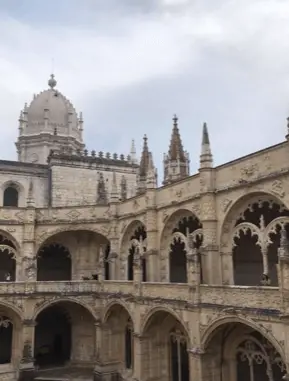
Do not miss the Jerónimos Monastery! The Jerónimos Monastery was built by King Manuel in 1501. He was known as Manuel the Fortunate because he was the king who got to reap the benefits of Vasco da Gama and the greatest Portuguese explorers.
In 1147 Vasco da Gama set out on his successful mission to discover a sea route to India.
His success made Portugal one of the richest countries in the world.
Manuel built the Jerónimos Monastery on the site where da Gama and his men prayed before leaving on their journey.
Now a UNESCO World Heritage site, along with the Torre de Belém a few hundred yards down the street, both buildings are among the few remaining examples of Manueline architecture – a style characterized by opulence and intricate stone-carving showing nautical and religious themes.
Address: Praça do Império 1400
GPS: 38.698062533207484, -9.206725359913055
T: 351 213 620 034
Hours: Closed until May 9. October to April open from 10 am – 5 pm, May – September 10 am – 6:30 pm, On Sundays from May – September the monastery closes at 6 pm.
Admission: €10. Children 12 and under are free. Ages 65 and older pay €5.
Official website:
Take bus 714 or 728, or you could take the train toward Cascais from Cais do Sodré train station, which takes about 10 minutes. Get off in Belém and walk west along the river.
Another option is the 15E tram, which takes 30 to 40 minutes. You can catch it at Praça da Figueira or Praça do Comércio.
Belém Tower / Torre de Belém
The Belém Tower is one of the most famous symbols of Lisbon. The tower is officially the Tower of St. Vincent / Torre de São Vicente. The structure, which resembles a castle, was built by King Manuel between 1514 and 1519.
The tower is 59 feet wide. It is four stories and 98 feet tall. The four stories are connected by a narrow, spiral staircase of 120 steps.
The Belém Tower is built from the same Lioz Limestone that was used to build the Jerónimos Monastery across the street.
Its original purpose was to defend Lisbon and the harbor from invaders. Over time it served as a customs house, a royal ballroom, and a dungeon. The top floor is an observation deck, which is currently closed.
Address: Torre de Belém, Avenida Brasilia
GPS: 38.6916° N, 9.2160° W
T: 351 213 620 034
Official website: http://DGPC | Museums and Monuments | Museums and Monumentos of DGPC | Belém Tower (patrimoniocultural.gov.pt)
In order to find the Belém Tower, follow the directions to the Jerónimos Monastery above, arrive in front of the monastery, and then continue to walk west along the river.
Tickets are €6. No charge for children under 12. Over 65 receive a 50% discount.
Normally there is free admission with a Lisboa card, but the tower is currently closed. Visitors can enjoy the exterior for free, or take in the sunset behind the tower.
Schedule: October – May 10 am to 5:30 pm. Last admission 5 pm
May to September 10 am – 6:30 pm. Last admission is 5 pm. Closed on Mondays.
Pastéis de Belém / Pastéis de Nata
Pastéis de Belém are the famous Portuguese yellow egg custard tarts which were invented by the monks at the Jerónimos Monastery.
The original recipe was sold to a bakery that neighbored the monastery in 1837.
They have closely guarded the secret recipe and have been selling these delicious pastries ever since.
If you want to try the original, be prepared for long lines.
Excellent copy-cat pastries can be found all over Lisbon. They are called Pastéis de Nata (creme pastries).
Only the ones found in the shop with the blue awning in the Belém neighborhood can be called Pastéis de Belém.
Try them all over the city and decide for yourself who makes the best pastéis.
Address: Rua de Belém 84
GPS: 38.697632907646074, -9.203240902242381
You will pass by the shop on your way to the Jerónimos Monastery.
To learn more, see my The big difference between Pastéis de Belém and Pastéis de Nata
St. George’s Castle / Castelo de São Jorge
Artifacts suggest that the tallest hill in Lisbon has been occupied by different tribes including the Celts, the Romans, the Visigoths, and the Moors since the 8th century BC.
The Muslim Moors, who occupied and ruled the area, built a walled fortress on the hilltop in 1050.
In 1147, Christian knights united under the first Portuguese king Afonso Henriques swept down from the north and evicted the Moors from the castle.
Today the Castelo de São Jorge holds a small museum.
Visitors can enjoy the castle’s courtyards and eleven towers.
In the Tower of Ulysses, there is a Camera Obscura telescope that shows close-up views of other sights around Lisbon.
Even without using the Camera Obscura, the Castelo offers some of the very best views of the city, the river, and the April 25 Bridge.
Address: Rua de Santa Cruz do Castelo
GPS: 38.714114280589946, -9.133486931077218
Walk up the hill or take Tram 12 or 28 from Paça Martim Moniz, or Bus 737 from Praça da Figueira. Enter the castle on Rua de Santa Cruz.
Limited parking is available at Portas do Sol and Chão do Loureiro.
T: 351 218 800 620
For more information, see my article In and around Castelo de São Jorge – Lisbon’s castle
Miradouro da Santa Luzia and Miradouro das Portas do Sol
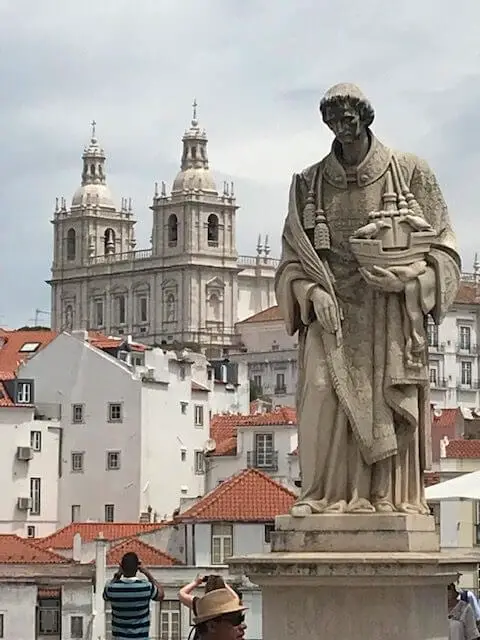
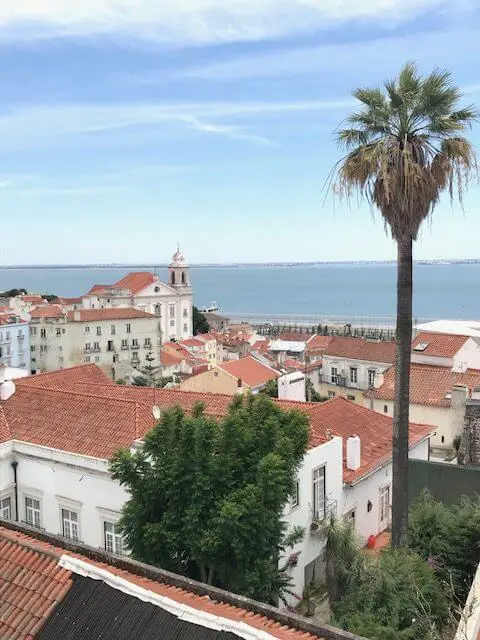

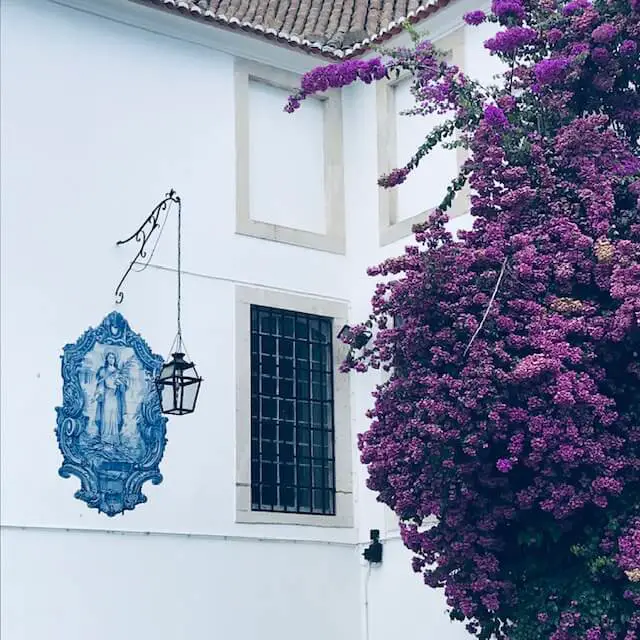
In Portuguese, “Miradouro” is a scenic viewpoint, literally, a “golden view.”
Lisbon has many miradouros, or golden views, but two of the best are located in the medieval Alfama neighborhood, not far from the castle.
The Church of Santa Luzia has a terrace with great views of the Alfama neighborhood and the Tejo River.
The white church is adorned with beautiful Bougainvillea bushes and azulejo tilework depicting the Seige of Lisbon in 1147 and the riverfront prior to the 1755 earthquake.
Not far from Santa Luzia is the Miradouro das Portas do Sol, with its great views of the river and the São Vicente de Fora Monastery.
Miradouro da Santa Luzia: Located on Rua do Limoeiro, Alfama, Santa Luzia GPS: 38.71178744376153, -9.130332702241965
Miradouro Portas do Sol: Located at Largo Portas do Sol GPS: 38.71276692940213, -9.129753345132597
These viewpoints are free to all. Walk up from Alfama, or Take Tram 28.
Don’t miss Tram 28

Tram 28 is one of Lisbon’s top attractions. It makes 28 stops, passing by some of the most important sights in LIsbon and provides the visitor with a great overview of this beautiful old city.
The yellow cablecar begins its route at Martim Moniz Square, and over the course of an hour makes its way to Campo D’ Ourique on the western side of Lisbon.
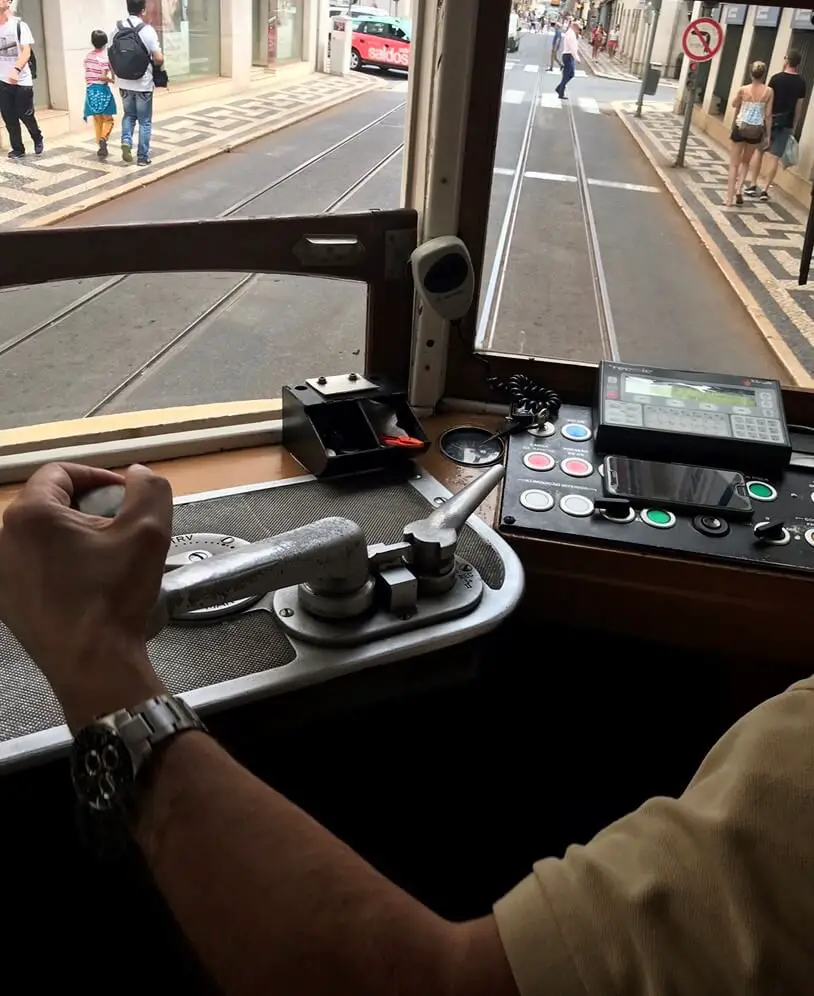
Tip: It may be easier to hop on when it is coming back to Martim Moniz, as the lines and wait times are extremely long.
Or ride very early, or very late.
The first trip is at 6 am, and the last run departs Martim Moniz at 11 pm on weekdays, and 10:30 on weekends.
One ride is €3 if you pay cash. You can get a discount by using the Viva Viagem Card.
Beware of highly skilled pickpockets on Tram 28.
First Stop: Martim Moniz Square
GPS: 38.71539691996509, -9.136187745132442
For more on Tram 28E, see my article Where does Tram 28 stop? All you need to know about Tram 28
Carmo Convent Ruins and Archaeological Museum / Convento do Carmo
The Convento do Carmo was built on the hilltop opposite the castle between 1389 and 1423.
The beautiful church was destroyed on the morning of November 1, 1755. The church was filled for Mass when the strongest earthquake to ever hit Europe struck.
More than 30,000 people died in the earthquake, and much of the city was destroyed by fires and a tidal wave following the quake.
As Lisbon was rebuilt, the decision was made to leave the Carmo Convent church as-is, to serve as a monument to the disaster.
Today visitors see the stone walls of the church and the beautiful vaulted arches that make up the skeleton of what was once a roof.
The National Archaeological Society also operates an Archaeological Museum at the Convento do Carmo.
Location: Largo do Carmo
GPS: 38.71238764397282, -9.140267559912655
You can reach the Convento do Carmo via the Santa Justa Lift on Rua do Ouro. There is also a free elevator one block west of the Elevador de Santa Justa. From the Baixa-Chiado metro station, exit to Chiado, or simply walk uphill from Rua Conceição in the Baixa district.
Hours: Monday -Saturday,
October – April 10 am – 6 pm
May – September 10 am – 7 pm
Closed on Sundays
Admission: €5 adults, €4 students, seniors, or Lisboa Card. Children under 14 are free.
Learn more at Lisbon’s Convento do Carmo Ruins | Everything You Need to Know
A day in Sintra
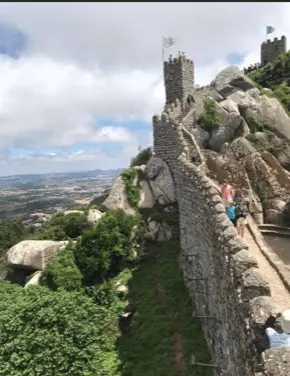
Pena Palace GPS: 38.787748154890245, -9.390673275251851
Sintra National Palace GPS: 38.79782573183459, -9.390848521275862
Moors’ Castle / Castelo dos Mouros GPS: 38.79274413024396, -9.389326873404181
Quinta da Regaleira Estate GPS: 38.7965020289236, -9.39603734300194
If you are looking at the map, Sintra seems kind of far from central Lisbon, but it is not difficult to access by train or bus, and the village is one of Portugal’s greatest treasures.
The trip takes roughly a half-hour. Located in the green forests of the Serra da Sintra mountain range, the town itself is a UNESCO World Heritage Site.
Sintra offers the medieval Castelo dos Mouros, the Romanticist-style Pena Palace, Sintra National Palace, the Quinta da Regaleira estate, and its famous wishing well, Montserrate Palace, fine gardens, and beautiful rugged beaches nearby.
At a minimum, every visitor to Lisbon should do a half-day trip to Sintra, but there is enough to see in the town that spending a night is a good idea.
For more information on Sintra, read my article, How to plan a day trip or overnight trip to Sintra from Lisbon
A day at the beach
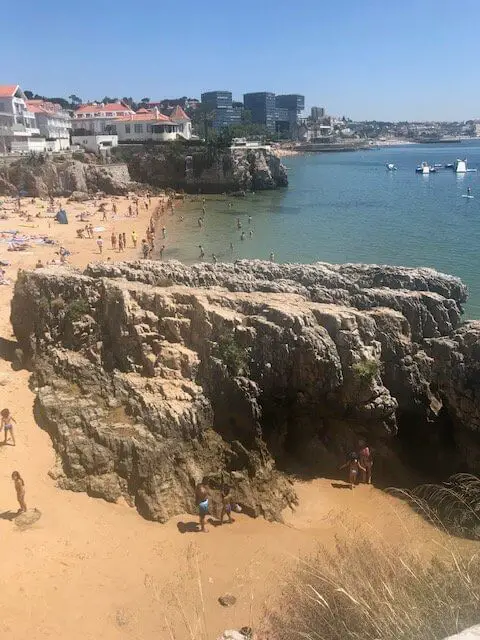
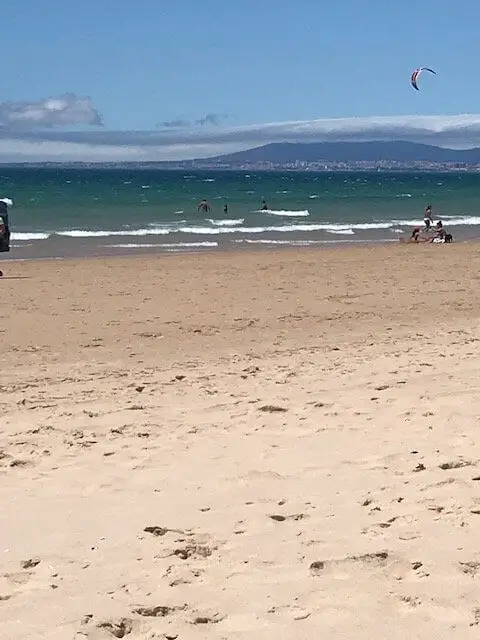
There are several great beaches that are not far from Lisbon. You can access all of them via public transportation. How to use public transportation to get to Lisbon’s beaches
Driving along the Tejo River west toward the Atlantic Ocean, you will come across Lisbon’s most popular beach – Carcavelos Beach.
The closest beach to Lisbon, it is always packed in the summer, and is particularly popular with surfers, bodyboarders, and beach volleyball players. There are plenty of restaurants, bars, and restroom and shower facilities. Lisbon’s most popular beach – Carcavelos Beach, Praia de Carcavelos
Further west are the resort beaches of Estoril and Cascais, which also make a great day trip.
While the beaches west of Lisbon are crowded, you can also use public transportation to find the more open beaches across the river on the Costa da Caparica.
While there are some crowds, there are 18 miles of blue flag beaches that are less crowded. The farther south you go, the more open the beaches.
There is even a nude beach and a gay beach.
Costa da Caparica is also very popular with kite-surfing, as it has perfect wind conditions. For more information, see my article, Explore Lisbon’s beaches on the Costa da Caparica
And a few other things to check out, if you have the time
Time Out Market / Mercado da Ribeira
Avenida 24 de Julho
Metro: Cais do Sodré station (Green line). The market is practically across the street from the metro station.
Opening hours: Weekdays 10am – 10:30pm, Weekends 10am-3:30pm
The beautiful Time Out Market has more than 26 restaurants, 8 bars, and a dozen shops.
In the other half of the building, is the Mercado da Ribeira, which is Lisbon’s oldest and the last fish market. They also sell a wide variety of fresh fruits and vegetables.
For more information on the Time Out Market, see my Lisbon’s Time Out Market | Everything you need to know
LX Factory – Arts center, shops, and eateries
Rua Rodrigues de Faria 103
GPS: 38.703868727823696, -9.178841643402126
Many bars and restaurants open late, but many of the shops are closed on Sundays.
The LX Factory is located a few blocks north of 25 April Bridge and the Santo Amaro docks. In order to get to the LX Factory, take buses 712, 713, 714, 727, 742, 751, 756 or 773 Also Tram 15 or 18. Get off at Santo Amaro bus / tram stop.
Visitors can shop for locally made souvenirs enjoy cocktails, have a meal, or appreciate murals and art installations at the LX Factory complex.
Formerly an industrial area, the buildings have been repurposed and now are home to popular restaurants, shops, and galleries.


My favorite is Ler Devagar – the Read Slowly Bookstore.
The bookstore and cafe are located in an old print shop, and visitors can climb up on the antique printing press. They also have a great collection of Portuguese music and vinyl.
For more information see my article Is the LX Factory worth visiting?
National Tile Museum / Museu Nacional do Azulejo

Address:
Rua Madre de Deus 4
GPS: 38.7247989987916, -9.113825531076927
T: 351 218 100 340
Hours: 10 AM till 1 PM, 2 PM till 6 PM
Closed Mondays
Admission: €5
There is a bus stop in front of the museum. Buses 718, 742, 794, (759 only at night)
There is another bus stop on Avenida Dom Henrique (a five-minute walk). Buses 728 and 759 stop there.
Uber or taxi are good options as well, as the neighborhood is not served by the subway.
This museum is a little off the beaten path, but if you appreciate the tilework you see around Lisbon, then you should not miss the National Tile Museum.
The museum presents a large collection showing how azulejo tiles have evolved from the fifteenth century until the twentieth century.
Surprisingly, the museum is housed in a convent that was built in 1509, and visitors will get to enjoy one of Lisbon’s most beautiful churches.
They also offer a free, all-ages tile-making workshop on Sunday afternoons at 2 pm.
Learn more: National Tile Museum in Lisbon | A Quick Guide
Thank you for reading 10 Things You Should Not Miss in Lisbon, Portugal. If you want to see the whole list of all of the things that are available in LIsbon, check out my article, 205 Things to do in Lisbon – The Ultimate Guide I am not associated with any business mentioned in this article.